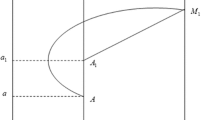Abstract
In this paper, a turbidostat model with impulsive state feedback control is considered. We obtain sufficient conditions of the global asymptotical stability of the system without impulsive state feedback control. We also obtain that the system with impulsive state feedback control may have order one periodic solution, and the sufficient condition for existence and stability of order one periodic solution is gotten as well. For some special cases, it is shown that in the system an order two periodic solution may exist. Our results show that the control measure is effective and reliable.
Similar content being viewed by others
References
Armstrong, R.A., McGehee, R.: Competitive exclusion. Am. Nat. 115, 151–170 (1980)
Butler, G.J., Wolkowicz, G.S.K.: A mathematical model of the chemostat with a general class of functions describing nutrient uptake. SIAM J. Appl. Math. 45, 138–151 (1985)
De Leenheer, P., Smith, H.L.: Feedback control for the chemostat. J. Math. Biol. 46, 48–70 (2003)
Flegr, J.: Two distinct types of natural selection in turbidostat-like and chemostat-like ecosystems. J. Theor. Biol. 188, 121–126 (1997)
Grover, J.P.: Resource Competition. Chapman and Hall, London (1997)
Hansen, S.R., Hubbell, S.P.: Single-nutrient microbial competition: Agreement between experimental and theoretical forecast outcomes. Science 207, 1491–1493 (1980)
Hsu, S.B.: Limiting behavior for competing species. SIAM J. Appl. Math. 34, 760–763 (1978)
Hsu, S.B., Hubbell, S., Waltman, P.: A mathematical theory of single-nutrient competition in continuous cultures of microorganisms. SIAM J. Appl. Math. 32, 366–383 (1977)
Levins, R.: Coexistence in a variable environment. Am. Nat. 114, 765–783 (1979)
Tilman, D.: Resource Competition and Community Structure. Princeton University Press, Princeton (1982)
Meng, X.Z., Jiao, J.J., Chen, L.S.: The dynamics of an age-structured predator–prey model with disturbing pulse and time delays. Nonlinear Anal.: Real World Appl. 9, 547–561 (2008)
Wolkowicz, G.S.K., Lu, Z.: Global dynamics of a mathematical model of competition in the chemostat: general response function and differential death rates. SIAM J. Appl. Math. 52, 222–233 (1992)
Laksmikantham, V., Bainov, D.D., Simeonov, P.S.: Theory of Impulsive Differential Equations. World Scientific, Singapore (1989)
Griffel, D.H.: Applied Functional Analysis. Ellis Horwood, Chichester (1981)
Zeng, G.Z., Chen, L.S., Sun, L.H.: Existence of periodic solution of order one of planer impulsive autonomous system. J. Comput. Appl. Math. 186, 466–481 (2006)
De Leenheer, P., Smith, H.L.: Feedback control for chemostat model. J. Math. Biol. 46, 48–70 (2003)
Li, B.T.: Competition in a turbidostat for an inhibitory nutrient. J. Biol. Dyn. 2, 208–220 (2008)
Zeng, G.Z.: Existence of periodic solution of order one of state-dependent impulsive differential equations and its application in pest control. J. Biomath. (in China) 22(4), 652–660 (2007)
Simeonov, P.E., Bainov, D.D.: Orbital stability of periodic solutions autonomous systems with impulse effect. Int. J. Syst. Sci. 19, 2562–2585 (1988)
Jiang, G.R., Lu, Q.S., Qian, L.N.: Complex dynamics of a Holling II prey–predator system with state feedback control. Chaos Solitons Fractals 31, 448–461 (2007)
Meng, X.Z., Chen, L.S.: Permanence and global stability in an impulsive Lotka–Volterra N-Species competitive system with both discrete delays and continuous delays. Int. J. Biomath. 1, 179–196 (2008)
Jiao, J.J., Chen, L.S.: Global attractivity of a stage-structure variable coefficients of predator–prey system with time delay and impulsive perturbations on predators. Int. J. Biomath. 1, 197–208 (2008)
Shi, R.Q., Chen, L.S.: Staged-structured Lotka–Volterra predator–prey models for pest management. Appl. Math. Comput. (2008). doi:10.1016/j.amc.2008.04.032
Shi, R.Q., Chen, L.S.: A predator–prey model with disease in the prey and two impulses for integrated pest management. Appl. Math. Model. doi:10.1016/j.apm.2008.06.001
Tang, S.Y., Chen, L.S.: Modelling and analysis of integrated management strategy. Discrete Contin. Dyn. Syst., Ser. B 4, 759–768 (2004)
Author information
Authors and Affiliations
Corresponding author
Additional information
Supported by National Natural Science Foundation of China (No: 10771179).
Rights and permissions
About this article
Cite this article
Li, Z., Chen, L. Periodic solution of a turbidostat model with impulsive state feedback control. Nonlinear Dyn 58, 525–538 (2009). https://doi.org/10.1007/s11071-009-9498-8
Received:
Accepted:
Published:
Issue Date:
DOI: https://doi.org/10.1007/s11071-009-9498-8




